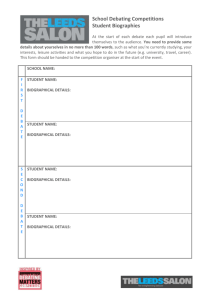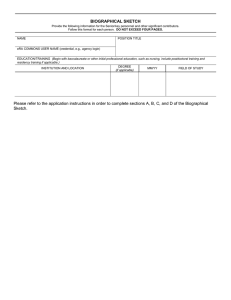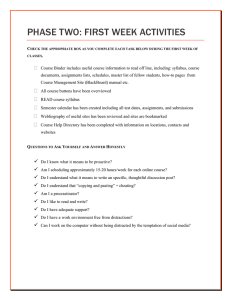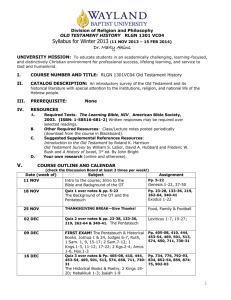NBST 515: New Testament Orientation I Syllabus
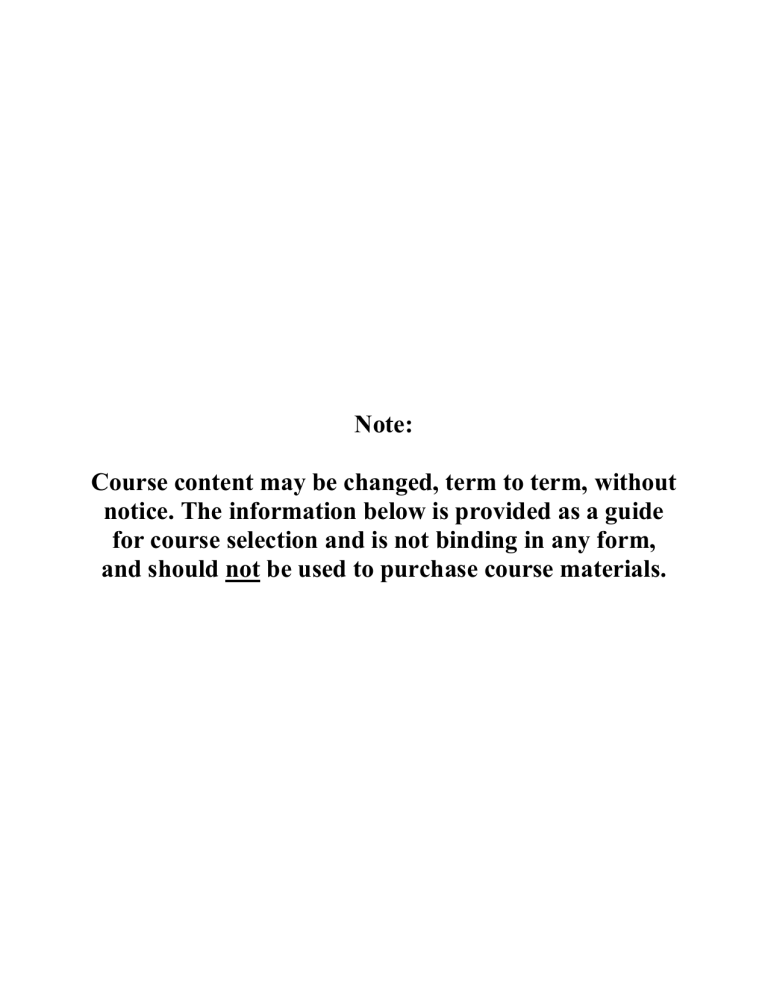
Note:
Course content may be changed, term to term, without notice. The information below is provided as a guide for course selection and is not binding in any form, and should not be used to purchase course materials.
NBST 515 Course Syllabus
C
OURSE
S
YLLABUS
NBST 515
N EW T ESTAMENT O RIENTATION I
C OURSE D ESCRIPTION
A general introduction to the New Testament Gospels, General Epistles, and Revelation, emphasizing matters of text, canon, authorship, date, authorial purpose, and theme development.
Also a special introduction, involving current issues of criticism and interpretation, such as the synoptic problem. The general principles of interpretation (hermeneutics) will be introduced as well as the special principles concerning parables, symbols and types, and prophecy.
R ATIONALE
This course will provide the student with an overview of both the background and content of the
New Testament. A broad look at the New Testament as well as the historical, cultural, political, and religious context allows the student to see how the specific message of a New Testament document interfaces with the whole.
I.
P REREQUISITES
For information regarding prerequisites for this course, please refer to the Academic
Course Catalog.
II.
R EQUIRED R ESOURCE P URCHASES
Click on the following link to view the required resource(s) for the term in which you are registered: http://bookstore.mbsdirect.net/liberty.htm
III.
A
DDITIONAL
M
ATERIALS FOR
L
EARNING
A.
Computer with basic audio/video output equipment
B.
Internet access (broadband recommended)
C.
Microsoft Word
(Microsoft Office is available at a special discount to Liberty University students.)
D.
The Holy Bible . A study Bible, such as the NIV Study Bible or NASB Study
Bible, is recommended but not required.
IV.
M
EASURABLE
L
EARNING
O
UTCOMES
Upon successful completion of this course, the student will be able to:
A.
Describe the social, economic, geographical, and political context of the New
Testament.
B.
Describe the major Jewish religious beliefs and religious movements of firstcentury Judaism.
C.
Explain the Synoptic Problem and the main scholarly theories that resolve it.
Page 1 of 4
NBST 515 Course Syllabus
D.
Describe the major events of Christ’s life and ministry.
E.
Define the main characteristics of each New Testament book covered.
F.
Demonstrate an understanding of the historical setting, major themes, interpretive issues, and literary genres of the New Testament documents covered in the course.
G.
Demonstrate an ability to think critically and perform evidence-based research by writing a biography of a key character in the Gospels.
V.
C OURSE R EQUIREMENTS AND A SSIGNMENTS
A.
Textbook readings and lecture presentations/notes
B.
Course Requirements Checklist
After reading the Syllabus and Student Expectations , the student will complete the related checklist found in Module/Week 1.
C.
Discussion Board Forums (3)
Discussion Boards are collaborative learning experiences. Therefore, the student is required to create a thread in response to the provided prompt for each forum.
Each thread must be at least 400 words and demonstrate course-related knowledge. In addition to the thread, the student is required to reply to 2 other classmates’ threads except for the final forum, which only requires 1 reply. Each reply must be at least 200 words. If sources are used, the student must use parenthetical citation. Acceptable sources include the following: the Bible; course textbooks; and other peer-reviewed, scholarly sources. Popular sources and
Internet sources are not allowed.
D.
Biographical Study
1.
Topic Approval
The student will choose a biblical character from a provided list on which to write his/her Biographical Study. The student will submit his/her topic to the instructor for approval.
2.
Bibliography
The student will prepare a bibliography with a minimum of 6 peerreviewed, scholarly sources. At least 1 of the scholarly sources must be a scholarly commentary. All sources must be in parenthetical citation format.
3.
Outline
The student will write an outline to include a working title of the
Biographical Study, a paragraph describing his/her research methodology, the outline, and his/her revised bibliography from the previous module/week’s assignment in current Turabian format. The outline itself must include an overall introduction and conclusion to the study as well as a description of all the lessons or sections that the study will contain.
Page 2 of 4
NBST 515 Course Syllabus
4.
PowerPoint
5.
The student will create a PowerPoint presentation in conjunction with his/her Biographical Study to be used in church settings. There is no required number of slides, but the PowerPoint must include the following: a title slide, an introduction slide, at least 1 slide for each lesson or section of the study, a conclusion slide, and a bibliography slide.
Paper
The student will write a 10–20-page research-based paper in current
Turabian format that focuses on the Biographical Study he/she has been working on throughout the course. The paper must include at least 6 scholarly sources in addition to the course textbooks and the Bible. All sources must be in parenthetical citation format.
E.
Exams (4)
Each exam will cover the Reading & Study material for the modules/weeks in which it is assigned. Each exam will be open-book/open-notes, contain 20 multiple-choice and true/false questions, and have a 40-minute time limit except for Exam 4. Exam 4 will contain 2 essay questions as well as 18 multiple-choice and true/false questions.
VI.
C OURSE G RADING AND P OLICIES
A.
Points
Course Requirements Checklist
Discussion Board Forums (3 at 100 pts ea)
Biographical Study
Exam 3
Exam 4
Topic Approval
Bibliography
Outline
PowerPoint
Paper
Exam 1
Exam 2
(Modules 1–2)
(Modules 3–4)
(Modules 5–6)
(Modules 7–8)
200
100
100
100
100
Total 1010
10
300
0
30
40
30
B.
Scale
A = 940–1010 A- = 920–939 B+ = 900–919 B = 860–899 B- = 840–859
C+ = 820–839 C = 780–819 C- = 760–779 D+ = 740–759 D = 700–739
D- =680–699 F =0–679
C.
Late Assignment Policy
If the student is unable to complete an assignment on time, then he or she must contact the instructor immediately by email.
Page 3 of 4
NBST 515 Course Syllabus
Assignments that are submitted after the due date without prior approval from the instructor will receive the following deductions:
1.
Late assignments submitted within one week of the due date will receive a 10% deduction.
2.
Assignments submitted more than one week late will receive a 20% deduction.
3.
Assignments submitted two weeks late or after the final date of the course will not be accepted.
4.
Late Discussion Board threads or replies will not be accepted.
Special circumstances (e.g. death in the family, personal health issues) will be reviewed by the instructor on a case-by-case basis
D.
Style Guidelines
All assignments for this course are to be formatted in accordance with the LBTS
Writing Guide and the latest edition of the Turabian style manual ( A Manual for
Writers of Research Papers, Theses, and Dissertations ). Discussion assignments and essay examinations may use the parenthetical citation style. All other written assignments should use the footnote citation style. Supplemental writing aids are available via the Online Writing Center .
E.
Extra Credit
No additional “for credit” assignments will be permitted beyond those given in the course requirements stated above.
F.
Course Changes
Course requirements are subject to change by the administration of the University at any time with appropriate notice.
G.
Disability Assistance
Students with a documented disability may contact Liberty University Online’s
Office of Disability Academic Support (ODAS) at LUOODAS@liberty.edu
to make arrangements for academic accommodations. Further information can be found at www.liberty.edu/disabilitysupport .
Page 4 of 4
COUR ### Course Schedule
C
OURSE
S
CHEDULE
NBST 515
Textbooks: Lea & Black, The New Testament: Its Background and Message (2003).
Scott, Jewish Backgrounds of the New Testament (2000).
M ODULE /
W
EEK
R
EADING
& S
TUDY
A
SSIGNMENTS
P
OINTS
1
2
3
Lea & Black: ch. 1
Scott: Introduction, chs. 1–7
2 presentations
1 case study
Lea & Black: chs. 2–3
Scott: chs. 8–12
1 presentation
Scott: chs. 13–18, Appendices A–H
1 presentation
Course Requirements Checklist
Class Introductions
DB Forum 1 Thread
Biographical Study – Topic Approval
DB Forum 1 Replies
Biographical Study – Bibliography
Exam 1
Biographical Study – Outline 40
4
5
Lea & Black: chs. 4–6
Bible Readings: Matthew, Mark,
Luke
1 presentation
Lea & Black: chs. 8–11
Gospel of John
1 presentation
Lea & Black: ch. 7
1 presentation
DB Forum 2 Thread
Exam 2
DB Forum 2 Replies
Biographical Study – PowerPoint
50
100
50
30
6
DB Forum 3 Thread and Replies
Exam 3
100
100
7
8
Lea & Black: chs. 19–21
Bible Readings: Hebrews, James, 1
Peter, 2 Peter
1 presentation
Lea & Black: chs. 22–24
Bible Readings: 1 John, 2 John, 3
John, Jude, Revelation
1 presentation
Biographical Study – Paper
Exam 4
200
100
T OTAL 1010
DB = Discussion Board
NOTE : Each course module/week begins on Monday morning at 12:00 a.m. (ET) and ends on Sunday night at 11:59 p.m. (ET). The final module/week ends at 11:59 p.m. (ET) on Friday .
10
0
50
0
50
30
100
